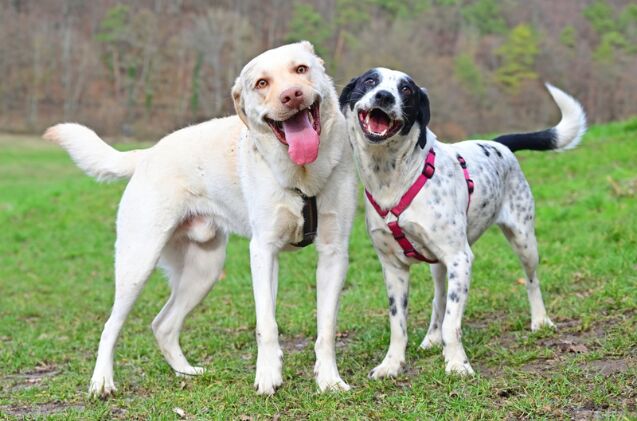Products
Why is My Senior Dog Restless at Night?
Final Thoughts
There are many reasons why your senior dog may be restless, pacing, and struggling to sleep through the night. The most common reason at this age is cognitive dysfunction, or “doggy dementia.” While it can be challenging to watch your best friend go through this struggle, there are steps that you can take to manage the situation and give them the best possible quality of life. This includes offering an elevated bed to take any pressure off their joints for a comfortable night’s sleep. Your senior pup will thank you for it!
Can Lick Mats Calm My Anxious Dog?
Our Go-To Solution: Hyper Pet IQ Treat Mat
The concept of the dog lick mat and its ability to help reduce stress and anxiety is one that I have been familiar with for quite a while. Having been actively involved in the rescue world, I have spent much time helping dogs from less-than-ideal situations adjust to their new (and better) lives. This often means finding ways to keep them calm as they learn that the world doesn’t have to be seen as scary.
More recently, we brought our youngest pup Lucifer into the family. Before adopting him, he had been through a traumatic situation that left him with some serious injuries to overcome – both physical and mental.
One of the best solutions we have found to help Lucifer deal with uncomfortable situations is to provide him with a Hyper Pet IQ Treat Mat and some of his favorite dog-friendly snacks.
For example, shortly after adopting him, we realized that car rides were uncomfortable for him. He would try to climb into my lap constantly for comfort or completely shut down due to his anxiety. We could distract and calm him during the ride by preparing a lick mat before heading out. Doing this regularly not only offered an immediate solution but also helped to create a positive association with the vehicle for future rides.
How Do I Stop My Dog From Digging up My Yard?
Have you recently stepped out into your yard to find little potholes all over the place? Before you run to Google to search for products to stop your dog from digging holes (there are plenty of companies that are more than willing to take your money), let’s start with understanding the basics.
Spoiler alert: When dealing with a dog behavioral problem, a quick solution is rarely something that will last over time.
In this article, we will look at why your dog has been digging holes in the yard and how you can prevent it without giving into the deterrent sprays and other aversive products offering big promises.
Which Dog Breeds Are Prone to Digging?
Digging holes is a natural behavior for dogs, meaning that any dog could enjoy creating a few holes around your yard if left unsupervised. This is especially common in dogs that are anxious, stressed, bored, or lacking a positive outlet for their pent-up energy. That said, some dog breeds are more likely to struggle with the temptation.
This includes:
- Terriers like the Jack Russell Terrier were bred to hunt rodents. These dogs are determined to get to their prey, even if that means having to dig down to them underground.
- Dachshunds, like terriers, were bred to follow their prey underground in tunnels and burrows.
- Another hunting dog that often seeks out prey underground is the Beagle.
- Northern dogs often dig in their natural habitat to make shelter and protect themselves from the elements. While dogs like the Siberian Husky and Alaskan Malamute now live in the comfort of our homes, they often still give in to their instinct to build a den.
- Rather than hunting dogs, some dog breeds, like the Lagotto Romagnolo, were bred to hunt truffles. This, of course, meant digging them up from the ground, instilling that desire to dig when a scent catches their attention.
Another situation where you may find your dog digging is when they are anxious or afraid. For example, if your dog is left in the yard when they hear frightening sounds like fireworks or a thunderstorm, they may start digging in a desperate attempt to escape and flee to safety. This is one reason experts recommend keeping our dogs indoors during holidays like July 4th when they are more likely to face these triggers.
Do Dog Talking Buttons Really Work?
Have you ever wished your dog could speak English, allowing them to tell you what’s on their mind? If so, you’re not alone! As dog parents, we learn how to read our best friend’s body language or pick up on their ability to communicate what they want with their actions. But many pet parents are now exploring a new opportunity to improve communication and teach their dogs to “speak” by introducing dog talking buttons.
But what are talking buttons, and how do dogs use them to communicate? Let’s look at this fun way to connect with your pup.
Do Talking Buttons Actually Work for Dogs?
Originally introduced to the world by speech-language pathologist Christina Hunger, dog talking buttons are a form of Augmentative Alternative Communication (AAC). This specialized communication approach is commonly used with human children as an alternative to verbal expression. AAC can be implemented with various devices and techniques, from high-tech tablets and computerized devices to sign language and flash cards.
Having plenty of experience with the techniques in her daily work, Hunger became curious about whether the same approach could be used to communicate with her dog Stella. From there, the talking button phenomenon was born.
Talking buttons are recordable devices programmed to say a word or phrase each time they are pressed. Dog parents can then teach their dogs to associate the button with that word and its meaning. For example, you may program a button in your home to say “outside” and teach your dog that pressing the button means they want someone to open the door and let them out in the backyard.
How Do I Protect My Pet From Wildfire Smoke?
With wildfires burning out of control across several locations in Canada and the United States, the smoke is reaching far and wide. As a result, many cities and townships have issued air quality warnings encouraging people to stay indoors, keep their windows closed, and avoid outdoor-heavy activities.
But what about our pets? Are our pets also susceptible to poor air quality?
Is Wildfire Smoke Harmful to Pets?
The short answer is YES! Like us, our pets can experience the negative effects of poor air quality from pollution or wildfire smoke. For some, this is just an uncomfortable or unpleasant experience. It can irritate their eyes and respiratory tract even with minimal exposure. However, it can be much more severe for those with pre-existing medical conditions, potentially causing drastic side effects.
How Can You Keep Your Camping Dog Safe at Night?
As the weather warms up, outdoor lovers everywhere are planning camping trips and outdoor adventures. Of course, the best trips are spent with your best friend by your side – enjoying exciting hikes, stunning landscapes, endless playtime, and cuddles by the campfire.
Safety must be a top priority to ensure that everyone enjoys a happy and enjoyable trip. This includes planning for an emergency, packing the right gear, and familiarizing yourself with the risks you may encounter during the day and after the sun goes down.
So, how do we keep our dogs safe while camping at night? Here are some outdoor travel safety basics…
How Do Cat Shelves Enhance Feline Enrichment?
Cats are natural-born climbers that love exploring their surroundings and discovering every nook and cranny. As a result, many cat lovers have seen their feline companions climbing on the fridge, bookshelves, and other furniture around the home. But what if you could offer a whole new vertical world specifically designed with them in mind?
Cat shelves are not new – many cat lovers have used them over the years. However, they have recently seen an incredible rise in popularity. The more we learn about the enrichment needs of our furry friends, the better we can adapt our home to improve their lives. These raised perches and kitty jungle gyms are a great way to do precisely that.
In this article, I will share the benefits of installing cat shelves in your home and the many types of cat shelves available. Plus, you can see how we have incorporated shelves into our new home for our two feline family members, Pippen and Jinx.
Let’s get started…
Should My Healthy, Active Dog Take Supplements?
As a devoted pet owner, providing your beloved dog with a happy, healthy life is a top priority. In today’s society, we are lucky to have a wide range of pet products available to us, making it easier than ever to overcome any challenges your dog may face regarding their health and well-being. Unfortunately, this can also make identifying the right products feel overwhelming. Does your dog need any supplements or vitamins? If so, what options should you consider?
As a dog mom with three active hiking dogs, I am often asked why I include supplements with my dogs’ meals and whether they are necessary. In this article, we will look at some of the most common supplements on the market, what they can help with, and how to decide if it’s time to introduce supplements into your dog’s diet.
Does Your Senior Dog Need Anti-Slip Paw Pads?
If you share your heart and your home with a senior dog, then you know that with age can come some significant changes. Your once highly energetic dog may slow down, sleep more, or experience mobility challenges. In their golden years, dogs often struggle to navigate stairs, get up on furniture (like the couch or bed), or safely walk across slippery flooring.
It can be hard to witness these changes, but you can still provide your beloved dog with an incredible quality of life. By understanding the unique struggles faced by senior dogs, you can take steps to make their lives a little easier and more comfortable.
In this post, we will discuss why your dog may be slipping more when walking through your home, the options available to reduce this slipping, and which option I use with my 15-year-old German Shepherd mix, Daviana.
Let’s get started!
Dog Theft is On the Rise: Keep Your Best Friend Safe
In recent years, there has been a concerning trend spotted by many pet professionals. As the demand for pets increased throughout the pandemic, so did the number of reported dog theft cases. As the world returned to normal, the dog-napping rates continued to rise. Beloved dogs are being taken from homes, yards, vehicles, or even on walks.
But why is dog theft so common, and what can you do to keep your dog safe?
How Many Dogs Are Stolen in the United States?
There is no reliable number that accounts for all dog thefts across the United States because dogs are viewed as property in the eyes of the law. Dog theft cases are included in the greater property theft count. But animal experts and non-profit organizations estimate the number to be around two million dogs stolen in the United States every year.
Dog Breeds That Are Most at Risk
While any dog is at risk of being stolen, there are some factors that could increase the risk for your pup. Purebred dogs are the most popular targets as they are in higher demand and can be sold for a more significant profit than mixed breeds. The same logic can be applied to a dog’s age, with puppies being the most valuable.
Smaller dogs are often targeted as they are easier to steal unnoticed and are seen as more adoptable than larger dogs.
The American Kennel Club identified six breeds as being the highest risk for theft, including:
- French Bulldog
- German Shepherd
- Labrador Retriever
- Siberian Husky
- Yorkshire Terrier
- Shih Tzu
Is Your Favorite Pet App Leaking Your Personal Information?
As technology grows and evolves, we find ourselves relying on it in nearly every area of our lives, from smart home innovation to the testing of autonomous vehicles. It comes as no surprise that tech has also found its place in the pet industry! Pet cameras, automatic feeders, and GPS tracking devices can all help us to give our pets the best possible lifestyle. But at what cost? What are the potential risks?
These questions are being raised in light of new findings from computer scientists at Newcastle University and Royal Holloway, University of London. Their study revealed that several popular pet tech apps and devices might be putting your privacy and safety at risk.
The study involved a detailed analysis of 40 popular Android apps in the pet space. This includes not only apps associated with products like wearable pet monitoring devices and smart feeders but also apps designed to track and record pet health information and veterinary records. They investigated many safety-related aspects of these apps, including what information they tracked and stored, how this information is protected, and how vulnerable the apps are to hackers and other cyber threats. The findings were surprising.
“Pet tech such as smart collars and GPS trackers for your cat or dog is a rapidly growing industry, and it brings with it new security, privacy, and safety risks to the pet owners. While owners might use these apps for peace of mind about the health of their dog or where their cat is, they may not be happy to find out about the risks the apps hold for their own cybersecurity,” explained Scott Harper, Newcastle Ph.D. student and lead author of the study.
“We would urge anyone using these apps to take the time to ensure they are using a unique password, check the settings and ensure that they consider how much data they are sharing or willing to share.”
Why Throwing Sticks for Your Dog Could Be Dangerous
Playing fetch with your dog is an age-old pastime that has brought joy to thousands of dog parents over the years. From throwing dog toys and frisbees to tennis balls and sticks, few activities are as closely associated with our canine companions. But many dog owners are unaware of the risks related to stick throwing.
It may seem like a harmless game, but throwing sticks for your dog could lead to horrific or even life-threatening injuries.
Stick-related injuries are surprisingly common, according to veterinarians and veterinary surgeons. While experts agree that playing with your dog is essential as a bonding opportunity and a source of physical exercise, they warn that you should swap out the stick for a dog-safe toy.
Types of Stick Injuries in Dogs
The first step to keeping our dogs safe is to recognize the risks so that we can take steps to avoid them. Unfortunately, stick injuries can come in several different forms, including:
- Injuries While Catching: If your dog can get ahead of the stick and catch it while it’s still in motion, there is always the risk that they will connect with it on the end instead of safely on the side. This can lead to sticks becoming lodged in their throat.
- Slivers or Splinters: Small pieces of wood can become lodged in your dog’s mouth or between their teeth. Not only are these small pieces of wood painful, but they may also lead to ongoing infections. If a wood splinter is eaten, it may cause a puncture, internal bleeding, or other damage to the digestive tract.
- Cut or Scrapes: As your dog catches or attempts to pick up the stick, there is a chance that they may suffer cuts or scrapes around the mouth, especially if the stick has sharp edges.
- Impalement: If your dog runs into a stick, there is the possibility that they may be impaled. This often occurs in the chest or throat, raising the risk of organ damage and significant blood loss. Impalement can also happen if a dog jumps to catch a stick and then lands on it.
- Choking Hazard: When your dog is chewing on a stick, they will often swallow small pieces of wood and bark that come off. These pieces pose a choking hazard.
- Intestinal Blockage: If swallowed without incident, those same pieces can still cause trouble later in the digestive process. They may lead to a blockage in the stomach or intestines, a potentially fatal condition.
Most Versatile Horse Breed
We often see equestrian sports and horse lovers divided into two camps – English and Western riding. But what about those riders that don’t fit into one or the other? If you have a more diverse interest in riding, you may wonder how to choose a horse for your needs. Are you forced to choose one style to focus on? Do you need to purchase a horse suited for each style? The good news is that some breeds are highly versatile and capable of being trained to perform in both styles skillfully. Here is our list of the 10 most versatile horse breeds to help you find your ideal riding partner.
American Quarter Horse
Best Dog Treats for Large Dogs
While many treats boast that they are suitable for dogs of all sizes, large dog parents know that their pups have a few specific needs. One of the biggest struggles is finding a large enough treat that our dogs will taste their reward when given.
Luckily, many great dog treats on the market were specifically made with larger dogs (and extra-large dogs) in mind. These treats are not only sized right for our dogs, but their nutritional benefits can help improve their health and well-being. It’s the perfect combination for dog owners that want to give their pups the world (and then some). But where do you find the right treats to meet all your needs?
Before you spend a few hours scouring through online stores or walking the aisles of your local pet store, we want to help. In this guide, we’re going to share our choices for the best dog treats for large dogs and some tips and tricks to consider while shopping. Let’s get started!
Best Horse for Older Riders
Many activities and pastimes can become more complicated with age. Riding is a physical activity. While some horses can offer a smooth, comfortable ride, this isn’t true in every case. In fact, the natural gaits of some horses will create a bumpy experience that can aggravate sore joints, back pain, and other ailments. This doesn’t mean you have to give up riding! Here is our list of the 9 best horses for older riders.


















